
All categories
Featured selections
Trade Assurance
Buyer Central
Help Center
Get the app
Become a supplier

(948 products available)








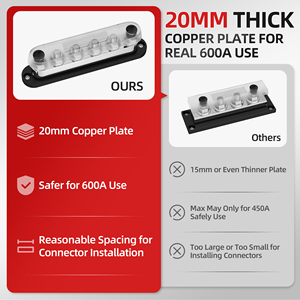
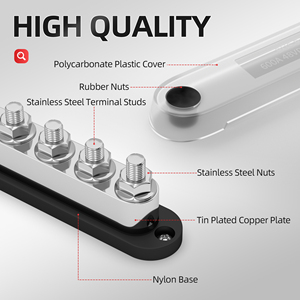






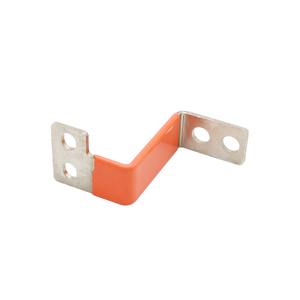



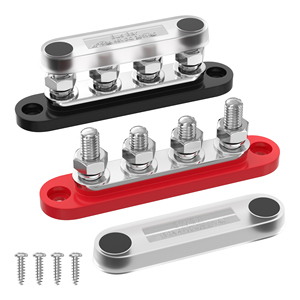
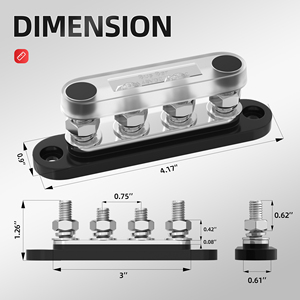
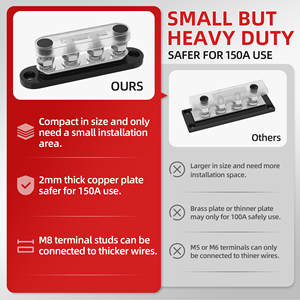




There are several bus bar 100A, including insulated, copper, aluminum, and busway. Each of these bus bars varies significantly, particularly in construction and application.
Copper Bus Bars
A copper bus bar is often the common choice in the industry. Thanks to its conductive properties, this metal offers excellent electrical conductivity. As a result of this and its durability, copper makes great investment material for electrical infrastructure. With a very high capacity for heat and current transfer, a copper bar is ideal for heavy-duty electrical applications.
Aluminum Bus Bars
Aluminum Bus Bars are lightweight alternatives to copper bus bars. While the conductivity of aluminum is lower, its lighter construction makes it suitable for applications where weight is a major concern. It is also a relatively cheaper option. Often, an aluminum bar is used in commercial and industrial settings. These settings require large-scale distribution and cost-effectiveness.
Insulated Bus Bars
An insulated bus bar consists of a bus bar that is covered with an insulating material. This insulating layer is designed to minimize the risk of short circuits and electrical shock. In these bus bars, the conductive element is usually made of copper or aluminum. The insulating material may be plastic, porcelain, or rubber, which provides a protective barrier. Insulated bus bars are primarily used in applications that require additional safety measures.
Segmented and Narrow Bus Bars
Segmented bus bars are designed to accommodate specific configurations. They feature narrow parts that can be customized to fit distinct electrical requirements. These bus bars are designed for flexibility. They suit applications where space constraints exist or where complex electrical layouts are needed.
Busways
Busways are compact and rigid electrical power distribution systems. They consist of a dedicated housing and a conductive element. They are used as an alternative to traditional wiring methods for the transmission of electric power. Busways are constructed for easy installation and offer the flexibility for future expansion or reconfiguration of electrical systems.
Bus bars are vital components in any electrical distribution system with high current. Besides conducting, they also serve to connect and consolidate various electrical elements.
Current Capacity
A Bus bar 100A can carry a maximum of 100 amperes of electrical current while performing optimally. This rating signifies its ability to distribute electrical currents with safety and efficiency. Moreover, these bus bars create the capacity of an electrical system to support larger power loads. This makes them ideal for both industrial and commercial uses.
Material Composition
Bus bars are made of varying materials. These materials include copper, aluminum, and brass. Copper is often preferred due to its superior electrical conductivity. It, therefore, enhances energy transfer efficiency. In this case, a copper bus bar is often the common choice for heavy industrial use because of its durability and corrosion resistance.
On the other hand, aluminum bus bars are lighter and more cost-effective. That makes them suitable for large-scale electrical installations. They have lower conductivity. It means they need larger cross-sections to carry the same current as a copper bus bar.
Corrosion Resistant Coatings
Bus bar 100AS are often equipped with corrosion-resistant coatings. These coatings ensure longevity and reliability in challenging environments. These elements could be industrial, marine, or outdoor settings where humidity and exposure to adverse elements are frequent. Typical coatings include tin, nickel, or silver plating.
Compact Design
The designs for bus bars are compact. Therefore, they allow for more efficient space utilization in any electrical system. Their functionality enables them to replace conventional wiring with a more organized and systematic approach to power distribution.
Insulation for Safety
Insulated bus bars were designed with safety as a priority. They feature insulating layers that help prevent electrical faults and short circuits. These layers are really helpful in minimizing the risk of electrical shocks. In addition, they also help improve the overall reliability of the electrical systems.
Heat Dissipation
Bus bars are designed with better heat dissipation capabilities. These allow them to operate efficiently even under heavy loads. This feature helps in maintaining desirable temperature levels to reduce the risks of overheating.
Bus bars, especially those with 100A ratings, serve in a variety of commercial settings. These spaces require efficient electrical power distribution.
Data Centers
Bus bars are critical components in these centers. Their versatility and compactness make them popular in power distribution systems in these spaces. These systems power servers, storage units, and other high-density computing equipment. Typically, insulated bus bars are used to distribute power while minimizing the risks of short circuits in these densely packed environments.
Manufacturing Facilities
Heavy machinery and equipment consume large currents in manufacturing facilities. For this reason, bus bars are employed to distribute electrical power to these equipments. These facilities allow for efficient energy transmission with minimum power loss. This improves the operations of machines and overall productivity.
Commercial Buildings
In large commercial buildings, the electrical systems are complex. Bus bars simplify these systems by consolidating power distribution. They provide an organized way to manage the electrical demands of lighting, HVAC systems, and other appliances. Henceforth, bus bars improve energy efficiency and reduce the likelihood of electrical overloads. This ensures a consistent power supply throughout the building.
Refineries and Chemical Plants
These facilities generally operate with electrical systems that handle large currents. In such spaces, a bus bar 100A is used to distribute electrical power safely and effectively. Insulated bus bars are especially valuable in these environments. They offer protection against electrical faults. This, ultimately, improves safety in spaces that handle flammable substances.
Power Generation Facilities
Bus bars play a crucial role as a power source to switchgear and transformers in power generation facilities. They are used in both electrical grids and backup power systems. In these applications, bus bars provide reliable power distribution, enhance system stability, and facilitate easy maintenance and future expansions.
Material
Buyers should pay attention to the type of material that makes the bus bar. Copper is often the better option for efficiency in conductivity. It offers better reliability and durability compared to aluminum. However, customers who prioritize cost and lighter weight can also settle for aluminum.
Design
Clients should choose a design that measures up to their installation and power distribution requirements. For instance, manufacturers of busway systems provide flexibility and ease of installation. On the flip side, segmented and narrow designs are more suited to specific configurations where space is a constraint. Buyers should consider such factors when selecting the ideal design for their customers. A good variety will help their business accommodate diverse needs.
Insulation
Buyers should also consider insulated bus bars. They are ideal for applications where safety is a core concern. These include commercial and industrial use cases that require protection against electrical faults and short circuits. Bus bars come with robust insulation. They would help the buyers cater to these safety needs. Insulation materials, by the way, typically include porcelain, rubber, and plastic.
Thermal Stability
Customers operating in high-thermal environments need a bus bar that can keep its cool under heavy electrical loads. Buyers should ensure that the bus bars possess good thermal conductivity to avoid overheating. Those with plating or coating are a good consideration. They enhance heat dissipation further.
Customization
If customers have specific electrical requirements, buyers should ensure they get customized bus bars. Luckily, the current market provides segmented or narrow bus bars that can be adjusted to fit unique configurations. Buyers should consider their customers’ space constraints or distinctive electrical layouts. They will most definitely benefit from customization.
Standardization and Compliance
Buyers should prioritize bus bars that meet industry standards. These standards ensure safety and reliability. In addition, compliance with international or local electrical codes will reduce the likelihood of legal issues regarding electrical systems. Ask clients about their space needs and electrical requirements and find a bus bar that meets all the mandatory standards.
Unfortunately, that’s not the case for all bus bars. While many are manufactured as single pieces, others can be segmented. Segmented bus bars are designed to accommodate specific configurations. Therefore, they feature narrow parts that can be customized to fit distinct electrical requirements. These bus bars are usually constructed using multiple pieces. It allows for flexibility in applications where space constraints exist. h3>Can bus bars handle high current loads?
Yes, they can. Bus bars are designed to carry high electrical current loads. They are ideal for heavy industrial and commercial electrical systems. Typical current capacities for power distribution bus bars range from 100 amperes up to 5000 amperes. High current loads heat the bus bars. To counter this challenge, they come with efficient heat dissipation properties. They maintain safe operating temperatures even under high loads, reducing risks of overheating.
Manufacturers enhance the corrosion resistance of bus bars by applying various plating materials. These plating materials include tin, nickel, or silver. They form a protective barrier against corrosion. For bus bars used in adverse environments, such as marine or industrial settings, these coatings are vital. They ensure long-term reliability and performance. Users should, however, ensure they go for bus bars with the right plating for the environment they intend to use them in.
The size of a bus bar is primarily determined by the electrical current it will be handling. It should also have sufficient capacity for heat dissipation. One should also consider the space available for installation, operational conditions, and whether there are any future expansion plans. The electrical load requirements will define its cross-sectional dimensions. Meanwhile, the operating conditions will determine the material and design. That harmonizes the size with both present and future needs.